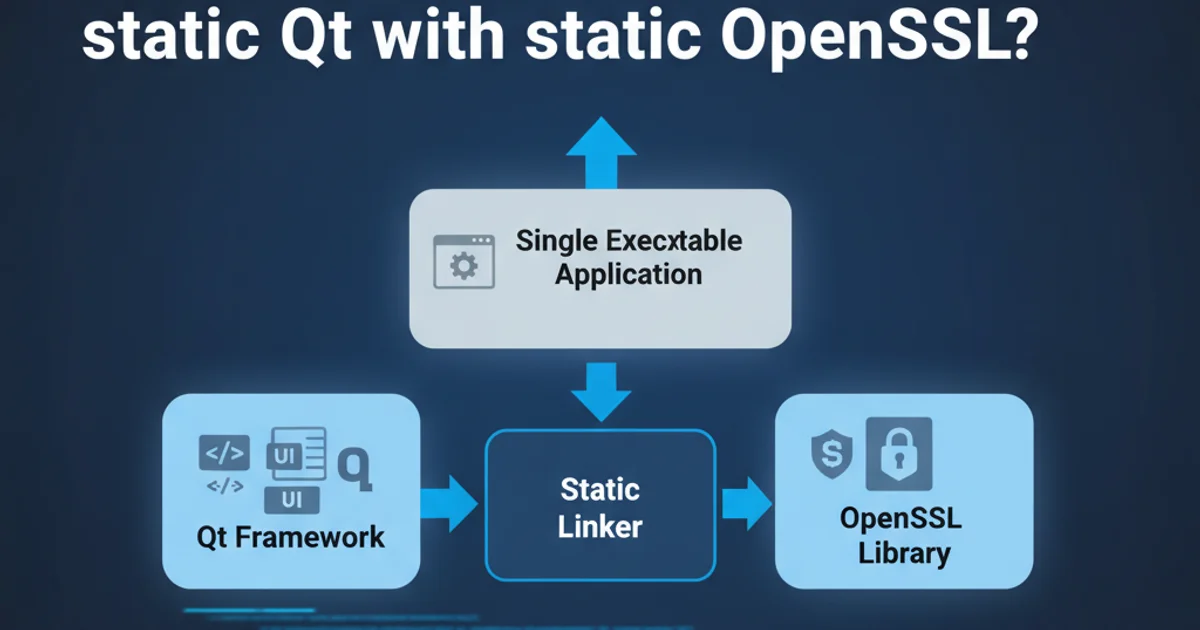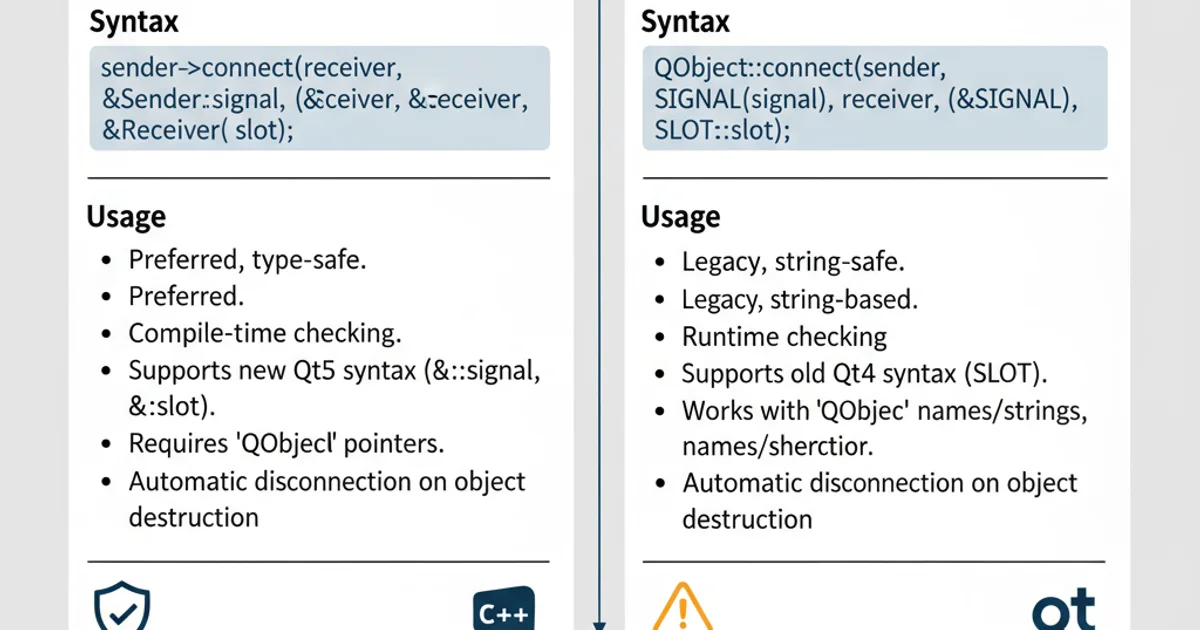Difference between QObject::connect vs connect methods
Categories:
QObject::connect vs. connect: Understanding Qt's Signal-Slot Mechanism

Explore the nuances between QObject::connect and the global connect function in Qt, and learn when to use each for robust signal-slot connections.
Qt's signal-slot mechanism is a core feature for inter-object communication, enabling loose coupling between components. At its heart are the connect functions, which establish these connections. However, developers often encounter two primary forms: QObject::connect (a static member function) and a global connect function (often used with C++11 lambda syntax). While both serve the same fundamental purpose, understanding their differences and appropriate use cases is crucial for writing clean, efficient, and maintainable Qt code.
The Evolution of Qt's Connect Syntax
Historically, Qt's signal-slot connections relied on a macro-based syntax, which, while functional, had limitations such as compile-time type checking and issues with overloaded signals/slots. With the advent of C++11, Qt introduced a new, type-safe syntax that leverages function pointers and lambdas, significantly improving developer experience and code robustness.
flowchart TD
A[Start] --> B{Qt Version?}
B -->|Qt4 or older| C[Macro-based Syntax (SIGNAL/SLOT)]
B -->|Qt5 or newer| D[Function Pointer/Lambda Syntax]
C --> E[Runtime Type Checking]
D --> F[Compile-time Type Checking]
E --> G[Potential for Runtime Errors]
F --> H[Improved Type Safety]
G --> I[Debugging Challenges]
H --> J[Easier Debugging]
I --> K[End]
J --> K[End]Evolution of Qt's connect syntax from macro-based to C++11 function pointers/lambdas.
QObject::connect (Static Member Function)
The QObject::connect static member function is the most common and recommended way to establish signal-slot connections in modern Qt. It offers compile-time type checking, which catches mismatches between signals and slots at compilation, preventing runtime errors. This form is particularly versatile, supporting function pointers, lambdas, and even the older macro syntax for backward compatibility.
// Using QObject::connect with function pointers
QObject::connect(sender, &Sender::valueChanged, receiver, &Receiver::updateValue);
// Using QObject::connect with a lambda
QObject::connect(button, &QPushButton::clicked, [=]() {
qDebug() << "Button clicked!";
});
// Using QObject::connect with the old macro syntax (discouraged for new code)
QObject::connect(sender, SIGNAL(oldSignal()), receiver, SLOT(oldSlot()));
Examples of QObject::connect with different syntaxes.
QObject::connect for new code. It provides superior type safety and readability compared to the macro-based SIGNAL/SLOT syntax.The Global connect Function (Often with Lambdas)
While QObject::connect is a static member of QObject, you might also see connect used without the QObject:: prefix, especially when dealing with lambdas. This is not a separate function but rather a convenience provided by Qt's global namespace or through using namespace Qt; or using QObject::connect;. When you use connect directly with a lambda, Qt's type inference often resolves it to the appropriate QObject::connect overload. This form is particularly popular for connecting signals to simple, inline logic.
// Global connect function (implicitly resolves to QObject::connect)
connect(button, &QPushButton::clicked, [=]() {
qDebug() << "Button was pressed.";
});
// Explicitly using QObject::connect for clarity (same as above)
QObject::connect(button, &QPushButton::clicked, [=]() {
qDebug() << "Button was pressed.";
});
Examples of the global connect function, often used with lambdas.
connect function is essentially an alias or a result of argument-dependent lookup (ADL) that resolves to QObject::connect. There isn't a fundamentally different underlying mechanism; it's primarily a syntactic convenience.Key Differences and When to Use Which
The primary distinction is less about two entirely different functions and more about the explicit versus implicit invocation of the same underlying mechanism. Both ultimately rely on QObject::connect.

Comparison of QObject::connect and the global connect function.
Here's a breakdown of when you might prefer one over the other:
1. Use QObject::connect explicitly:
When connecting signals to member functions (slots) of other QObject instances. This is the most common and explicit use case, providing clear intent and full type safety.
2. Use connect (global/implicit):
When connecting signals to C++11 lambdas, especially for short, inline operations. The global connect form is often more concise and readable in these scenarios. It implicitly resolves to QObject::connect.
3. For clarity and consistency:
Many developers prefer to always use QObject::connect for consistency, regardless of whether they are connecting to a slot or a lambda. This makes the code more explicit about the Qt framework's involvement.
SIGNAL/SLOT macro syntax with the new function pointer/lambda syntax in the same project if possible. While Qt supports it for backward compatibility, it can lead to confusion and negate the benefits of compile-time type checking.